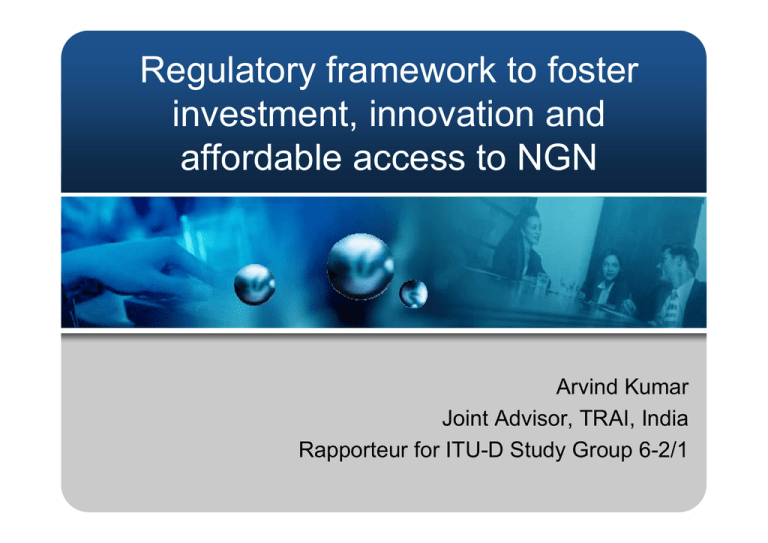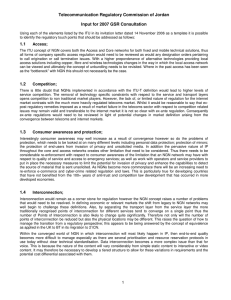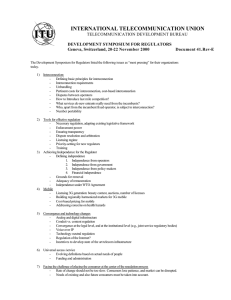Regulatory framework to foster investment, innovation and affordable access to NGN Arvind Kumar
advertisement

Regulatory framework to foster investment, innovation and affordable access to NGN Arvind Kumar Joint Advisor, TRAI, India Rapporteur for ITU-D Study Group 6-2/1 What is required ? • • • • • • A proactive regulatory regime Innovative polices Standardisation Access Regulation Interconnection Regulation Quality of Service Definitions … ITU • A Next Generation Network is a – packet-based network able to provide telecommunication services – able to make use of multiple broadband access technologies – QoS-enabled transport technologies, and – in which service-related functions are independent from underlying transport-related technologies Intelligence: shifts from the network to the service Next Generation Networks - Legacy telecom and wireless services Access Telephony SMS / MMS Transport IP-enabled services Gateways Transport Access VoIP and Multimedia Services Intelligent network Source :ITU, ECTA Gateways Intelligent infrastructure Intelligent infrastructure is the key enabler NGN is characterized by … • Packet-based transfer • Separation of control functions among bearer capabilities, call / session, and application / service • Decoupling of service provision from network, and provision of open interfaces • Support for a wide range of services, applications and mechanisms based on service building blocks (including real time / streaming / non-real time services and multi-media services) • Broadband capabilities with end-to-end QoS • Interworking with legacy networks via open interfaces • Generalised mobility Source : ITU, ECTA, ICANN War of the worlds Telco world Internet world • Closed • Open • Service charges • Access only • Service control • Self provision • Intelligent network • Dumb network • Dumb terminal • Intelligent terminal Source :ITU, ECTA, ICANN What NGN bring ? • Is it any big revolution ? – just about technology and infrastructure? – also changing behavior patterns of consumers? – changing business models? – Changing equation between Incumbent and new telcos • Uncertainty? – new architectures, new protocols and new types of access, interconnection – operators may face yet unknown challenges - investment highly risky A proactive Regulatory regime • • • • Enabling environment at all levels Transparent regulatory polices Enforcement of Rules Remove undue regulatory barriers to competition • Establishing investment friendly regulation • Regulatory certainty for both incumbent and other service providers • Seamless transition Innovative polices • • • • Establishment of Converged Regulator Parallel existence of PSTN/IP network Complete NGN environment-Long term Different architecture-network, services and applications • NGN and Internet • NGN-engine for convergence Standardisation and interoperability • An important element of the policy framework for NGN – circuit-switched telco and the Internet packet-switched world come together – standards and interoperability of telco and Internet very different! – Regulators may think to an arrangement where interoperability standards are determined by the industry through central co-ordination Issues embedded by standardisation … Regulatory … • • • • • • • • • Emergency calls Legal interception Numbering Number portability Quality of service (parameters, grade of service, etc.) Control of expenditure Caller location Privacy Network integrity Competition … • Standards to improve competition – service – core – access Interconnection and network access • Interconnection between public telecommunications networks has been regulated in most countries while IP interconnection has not – Internet : exchange of traffic is organized via peering agreements – telco world: cost-based Interconnect Usage charges – in the transition to an NGN world those two worlds will overlap • Controlled ways to access or bypass existing and future infrastructure and thereby reduces market entry barriers for all market players Interconnection: Corner stone of competition • Interconnection is fundamentally important because the telecom system must function as a single system • Investment in one part of the network creates potential benefit across the whole network • Network is as strong as its weakest link • SMPs try to impose as much of the network cost as possible on new players Interconnection: Corner stone of competition • Interconnection is not one time problem to be solved but on going issue to be monitored and managed • Interconnection regulations must be modified periodically with changing technologies • Interconnection Regulation must be changed over time Interconnection: Corner stone of competition • Transformation from technical into an economic issue • New technologies and the changing economics of the industry and its markets are major contributing factor to the structural change in telecom • Identify the techno economic factors that are driving the new design of networks and their implications for policy and regulation • Ex-ante access regulation for NGN • Ex-ante Interconnection regulation for NGN • IP interconnection Quality of Service • Telco world: no difference in quality between players • In an NGN world: Quality of Service can be expected to be an important differentiating factor in competition • View being established is that markets for low quality and for high quality may develop – regulators should not encourage one over the other , awareness among consumers is required so that they can take informed decision • Market should be left to determine prices and conditions in the context of quality of service • Market parties should be able to qualify their QoSneeds in the context of interconnection Introduction to Study Group Question 6-2/1 • Study group 1-Regulatory issues • Working Procedure in accordance with Resolution 1 and 2 of WTDC-06 • Question 6-2/1 :Regulatory impact of Next Generation Network on Interconnection • First meeting Study group :4th Sep - 6th Sep 2006 Introduction to Study Group Question 6-2/1 • Regulators today are concerned about bottleneck facilities in incumbent’s network • This question provides an opportunity to the Regulators to discuss issues • In the service area, If all the service providers migrate simultaneously to NGN then we would have least issues. • But in reality, This will be continuous process, one operator will migrate to NGN early other will follow… • Therefore TDM-NGN-TDM have to work for certain period • Concept of Provider and Seeker has to re-visited. • Reference Interconnect offer from SMP is to be mandated ? The interconnect Iceberg Technical issues Commercial issues The interconnect Iceberg Technical Standards Commercial issues What is architecture ? Physical nodes for interconnection Interconnect agreement Limitation in present License Commercial viability Practical contracts Transition arrangements Testing/Trials Support of legacy services Support of new services All issues are further complicated as • There would be number of obligatory and non obligatory products • We need Short term, medium term and long term solution • May be 4 to 6 operators • Interconnection agreements, contracts, Interconnection location etc… Introduction to Study Group Question 6-2/1 • Relevant input document and Liaison statements: – ITU-T SG 3,SG 11,SG 13,SG16 – ITU-D SG 19-2/1 • Work plan – – – – Study Group 1 Meeting 18 – 21 September 2007 Your contributions welcome! Interim report by end of 2007 This interim report will identify issues and potential challenges to NGN Interconnection Contact Information Arvind Kumar Email :arvindtrai@rediffmail.com Ph No. :+91-11-23220209 (work) +91-9810428700(Mobile)

